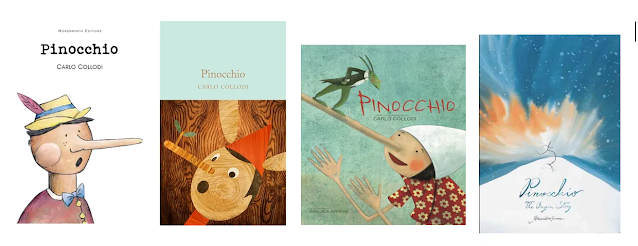Any copy of Pinocchio in English is a translation from the original story written in 1883 by Carlo Collodi whose real name was Carlo Lorenzini. His pen name, Collodi, refers to the name of the village where his mother was born. Every time I pick up a copy of Pinocchio I check to see the name of the translator. Often this is not mentioned. My copy featured today says: text adapted and abridged by Elizabeth Haserick.
So, as you can see my copy here today is both a translation, of course, and an abridged version. The actual novel of Pinocchio is 288 pages. I have not read the full book but my version today covers the main incidents. This one illustrated by Greg Hilderbrandt is long out of print but it is sure to be in many libraries. It is a long format picture book and would make a great family read aloud.
Pinocchio is available in many formats from board books to picture books and novels as well as ebook versions and it has been translated into 300 languages. There are also very simple versions such as one from Ladybird books. When I searched on Goodreads I found over 3500 versions of this famous classic.
The story was originally published in serial form as The Story of a Puppet (Italian: La storia di un burattino) in the Giornale per i bambini, one of the earliest Italian weekly magazines for children, starting from 7 July 1881. Near Florence you can visit Pinocchio Park.
Chapter 1: Pinocchio's Creation
In the first chapter, the kind-hearted woodcarver Geppetto creates Pinocchio out of a magical piece of wood. As soon as Pinocchio comes to life, he starts causing trouble and running away, setting the stage for his misadventures.
Chapter 2: Pinocchio's First Misadventure
Pinocchio encounters the cunning Fox and Cat, who persuade him to join a puppet theater. However, Pinocchio soon realizes that the puppet master intends to turn him into firewood. With the help of the Blue Fairy, Pinocchio escapes, but not without facing consequences for his gullibility.
Chapter 3: Pinocchio's Encounter with the Talking Cricket
Pinocchio meets the Talking Cricket, who advises him to be obedient and honest. Annoyed by the cricket's wise words, Pinocchio throws a hammer at him, inadvertently killing him. This impulsive act sets the stage for Pinocchio's journey of personal growth and redemption.
Chapter 4: Pinocchio's Trip to the Land of Toys
Pinocchio is lured to the Land of Toys, where children can play all day without consequences. However, Pinocchio soon discovers that the Land of Toys is a trap, turning disobedient children into donkeys. He narrowly escapes this fate but is left with donkey ears and a tail as a reminder of his foolishness.
Chapter 5: Pinocchio's Rescue of Geppetto
Pinocchio embarks on a mission to rescue his father figure, Geppetto, who has been swallowed by a giant shark. With courage and determination, Pinocchio saves Geppetto and learns the importance of selflessness and sacrifice.
Chapter 6: Pinocchio's Transformation into a Real Boy
Pinocchio's bravery and selflessness finally earn him the reward he has longed for – a transformation into a real boy. Through his journey, Pinocchio learns the value of honesty, bravery, and the importance of making virtuous choices.
I visited Italy last year. I was intrigued to see every market in Tuscany had Pinocchio puppets for sale in all sizes and price points. Then I went into a beautiful huge bookstore where they had a whole shelving bay full of different versions of Pinocchio. Here is my photo:
There are many ways you could read or use the story of Pinocchio with your class. In art you could compare all the different cover illustrations or look at the work of the famous illustrators below. This book is also a terrific example of a trickster tale. Take a look at my small Pinterest collection. As a read aloud, you could read one story incident each day. My friend from Kinderbookswitheverything shares the books that feature Pinocchio from her library.
As you would imagine many very famous illustrators have created their own images for this famous story.















No comments:
Post a Comment